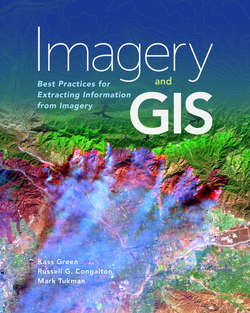Читать книгу Imagery and GIS - Kass Green - Страница 13
На сайте Литреса книга снята с продажи.
Imagery Data Structure
ОглавлениеAs measurements, all images are continuous data. Continuous data is measured on a continuum and can be split into finer and finer increments, contingent upon the precision of the sensor making the measurements. Sensors that capture imagery return numerical values within a range defined by the sensing instrument.
Most remote sensors collect data in a rectangular array, and remotely sensed data not captured in a rectangular array is usually resampled into a rectangular array after collection. Examples of image data include imagery collected from optical sensors, such as that collected by USGS’s Landsat satellites and by contractors collecting aerial National Agricultural Imagery Program imagery for the USDA.
Discreet point location measurements, such as those from weather stations or buoys, are also represented in a rectangular array. Three-dimensional (x, y, and z) point data, such as that collected by lidar sensors, is referred to as a point cloud, but also often transformed into a rectangular array for both visualization and analysis (figure 2.2).
Figure 2.2. Lidar returns from a Teledyne Optech Titan bathymetric lidar system. The image is color coded by elevation for both topographic height and water depth. Source: Teledyne Optech.
Image files are structured as gridded rectangular arrays or raster data, with each cell representing a measurement value captured by the remote sensing measurement. The data is stored as rows and columns of contiguous rectangular cells laid out in a grid (figure 2.3). Each cell contains a value. The values may be integer or floating point. The cells of an image raster are often referred to as picture elements or pixels and contain data values that measure some characteristic of each cell’s location, such as its temperature, elevation, or spectral reflectance.
Because each cell has both a row and column location within the grid, the cells have inherent coordinates even though those coordinates may still need to be converted to map coordinates if the imagery is to be used in a GIS with other GIS layers (see chapter 6 for more information on georeferencing imagery).
Figure 2.3. A two-dimensional raster grid. Most imagery is stored as a raster where each cell is referred to as a pixel and has an associated x and y coordinate.
